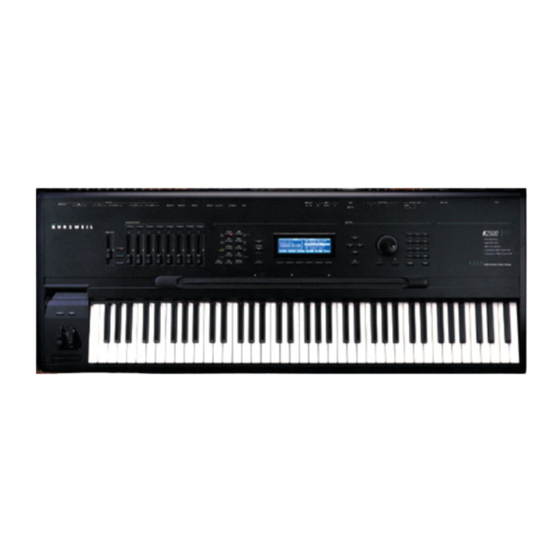Table of Contents
Advertisement
Quick Links
Chapter 5
Editing Conventions
Introduction to Editing
Programming (editing) the K2500 always involves three basic operations: mode selection,
navigation, and data entry.
First, select the mode that relates to the object you want to edit—a program, a setup, etc. Then
select the object you want to edit, and press the EDIT button to enter the editor within that
mode. An editor contains all the parameters that define the object you're programming.
Next, you navigate around the editor's page(s) with the soft buttons, and select parameters
with the cursor buttons. When you've selected a parameter (its value is highlighted by the
cursor), you can change its value with one of the data entry methods. When you change a
value, you'll normally hear its effect on the object you're editing. The K2500 doesn't actually
write your editing changes to memory until you save the object you're working on. It then
allows you to choose between writing over the original object, or storing the newly edited
version in a new memory location.
What's an Object?
If you've been wondering what we mean by the term "object," it's an expression we use for
anything that can be named, saved, deleted, or edited. Here's a list of all the types of objects:
•
•
•
•
•
•
•
•
•
•
•
•
•
Samples —digital recordings of instrumental sounds or waveforms. Samples actually
have two separate parts: the actual sample data and the sample header information,
which contains start, alternative start, loop, and end points, as well as the information on
the MISC page.
Keymaps —collections of samples assigned to specific velocity ranges and/or keys.
Programs —factory preset or user-programmed sounds stored in ROM or RAM. A
program is one or more layers of sound, with programmable DSP functions applied to the
keymaps within each layer.
Setups —factory preset or user-programmed MIDI performance presets consisting of up
to eight zones, each with its own program, MIDI channel, and controller assignments.
Songs —Type 0 MIDI sequence files loaded into RAM, or MIDI data recorded in Song
mode.
Effects —factory preset or user-programmed configurations of the K2500's onboard digital
audio effects processor.
Quick access banks —factory preset or user-programmed banks of ten entries each, that
store programs and setups for single-button access in Quick Access mode.
Velocity maps —factory preset or user-programmed curves that affect the K2500's
response to, and MIDI transmission of, attack velocity values.
Pressure maps —factory preset or user-programmed curves that affect the K2500's
response to, and MIDI transmission of, pressure (aftertouch) values.
Intonation tables —factory preset or user-programmed tables that affect the intervals
between the twelve notes of each octave.
Master table —the values that are set for the global control parameters on the Master
mode page, as well as the settings for the parameters on the CHANLS page in MIDI
mode, and the programs currently assigned to each MIDI channel.
Name table —contains a list of dependent objects needed by the other objects in a file at
the time the file was saved.
Macro —list of disk files to be loaded into the K2500's memory at start-up time.
Editing Conventions
Introduction to Editing
5-1
Advertisement
Table of Contents

Summary of Contents for Kurzweil K2500 - PERFORMANCE GUIDE REV F PART NUMBER 910251 CHAP 5
- Page 1 Editing Conventions Introduction to Editing Chapter 5 Editing Conventions Introduction to Editing Programming (editing) the K2500 always involves three basic operations: mode selection, navigation, and data entry. First, select the mode that relates to the object you want to edit—a program, a setup, etc. Then select the object you want to edit, and press the EDIT button to enter the editor within that mode.
- Page 2 You can enter objects as values by entering their IDs with the alphanumeric pad. This is especially convenient for programs, since their ID numbers are the same as their MIDI program change numbers (when you’re using the Extended or Kurzweil Program Change format—see “Program Change Formats” in Chapter 10).
- Page 3 Editing Conventions Saving and Naming |||||||||||||||||||||||||||||||||||||||| |||||||||||||||||||||||||||||||||||||||| |||||||||||||||||||||||||||||||||||||||| Save|Righteous|Piano|before|exiting?|||| |||||||||||||||||||||||||||||||||||||||| |||||||||||||||||||||||||||||||||||||||| |||||||||||||||||||||||||||||||||||||||| |||||||||||||| Rename| Cancel| Yes|||| No||| The best way through this process is to press the Rename soft button. This takes you immediately to the naming dialog, where you assign a name to the object you’re saving. You haven’t saved yet, but you’ll be able to after you’ve named the program.
- Page 4 Editing Conventions Deleting Objects |||||||||||||||||||||||||||||||||||||||| |||||||||||||||||||||||||||||||||||||||| |||||||||||||||||||||||||||||||||||||||| Save|Righteous|Piano|as: |ID#200||||||||| |||||||||||||||||||||||||||||||||||||||| |||||||||||||||||||||||||||||||||||||||| |||||||||||||||||||||||||||||||||||||||| Object||||||||||||||Rename|Save|||Cancel ROM Objects If the object you started from was a ROM (factory preset) object, the K2500 will automatically suggest the next available (unused) ID as the ID for the edited object. If that’s the ID you want, press the Save soft button, and the object will be stored in RAM with that ID.
- Page 5 Editing Conventions Memory Banks Memory Banks To help organize the storage of your edited objects, the K2500’s memory is divided into ten banks, each of which stores objects having IDs within a certain range. Objects within the same range of IDs are stored in the same memory bank, regardless of their types. The banks are in increments of 100, that is, objects with IDs from 1 through 99 are stored in the first bank, IDs from 100 to 199 in the second bank, and so on.
- Page 6 Editing Conventions Special Button Functions Special Button Functions The mode buttons, as well as few of the other buttons, have additional functions, as described below: Program / Mute 1 When you’re in the Program Editor, this button will mute Layer 1 of the current program or the currently displayed layer for drum programs.

















Need help?
Do you have a question about the K2500 - PERFORMANCE GUIDE REV F PART NUMBER 910251 CHAP 5 and is the answer not in the manual?
Questions and answers